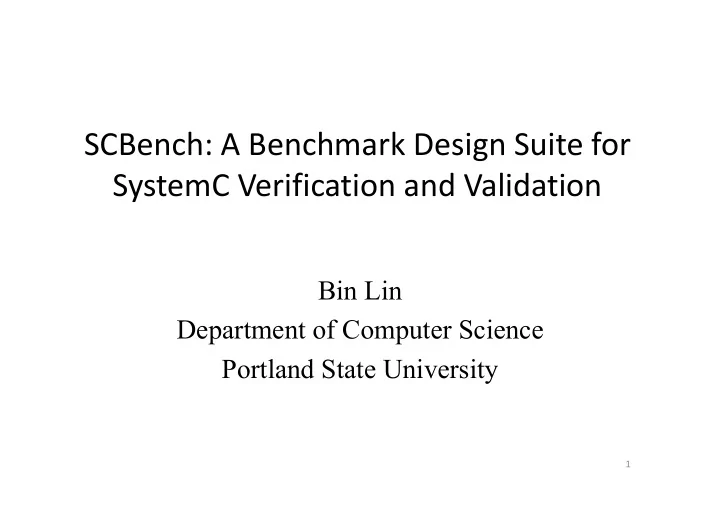

SCBench: A Benchmark Design Suite for SystemC Verification and Validation Bin Lin Department of Computer Science Portland State University 1
Agenda • Background and Motivation • Overview of Benchmark Designs • Key Features of SCBench • Characteristics of SCBench • Benchmark Validation • Summary and Future Work 2
What is SystemC? • A hardware description language (HDL) extending C++ • A set of C++ classes and macros for hardware design • IEEE Standard 1666™ ‐ 2011 3
Major SystemC Structures System (Module) Submodule Submodule Process Process Channels Signals Process Port Port Port 4
Motivation • The quality of SystemC designs is critical • It is challenging to assure the quality of SystemC designs • It is important to evaluate the performance of SystemC verification approaches • There lack common and up ‐ to ‐ date benchmarks 5
Agenda • Background and Motivation • Overview of Benchmark Designs • Key Features of SCBench • Characteristics of SCBench • Benchmark Validation • Summary and Future Work 6
Overview of Benchmark Designs Categories # Designs SystemC Specifics CPU architecture 8 Modules, Hierarchical modules, SC_METHOD, SC_THREAD, SC_CTHREAD, Security 6 Ports, Interfaces, Signals, FIFOs, Events, Timers, Digital signal processing 4 Bit vectors, Automotive and 4 Fixed ‐ point numbers, industrial Fixed ‐ precision types, Image processing 3 Arbitrary ‐ precision types, Network 3 LT/AT coding styles, Blocking transport interface, Artificial intelligence 1 Non ‐ blocking transport interface, Classical concurrent 4 Direct memory interface, scenarios Debug transport interface, TLM ‐ 2.0 5 Generic payload 7
Agenda • Background and Motivation • Overview of Benchmark Designs • Key Features of SCBench • Characteristics of SCBench • Benchmark Validation • Summary and Future Work 8
Key Features of SCBench • Consists of 38 well ‐ written SystemC designs • Ranges from small single ‐ process to large multi ‐ process designs • Provides a testbench and a set of stimuli for each design • Freely available online at (http://svl.cs.pdx.edu/scbench/scbench.html) 9
Agenda • Background and Motivation • Overview of Benchmark Designs • Key Features of SCBench • Characteristics of SCBench • Benchmark Validation • Summary and Future Work 10
Characteristics of SCBench Fig. 1. Occurrence Rate of Operations per Design 11
Characteristics of SCBench (cont.) Fig. 2. Occurrence Rate of Statements per Design 12
Agenda • Background and Motivation • Overview of Benchmark Designs • Key Features of SCBench • Characteristics of SCBench • Benchmark Validation • Summary and Future Work 13
Benchmark Validation Fig. 3. Testbench 14
Benchmark Validation (cont.) Fig. 4. Code Coverage 15
Agenda • Background and Motivation • Overview of Benchmark Designs • Key Features of SCBench • Characteristics of SCBench • Benchmark Validation • Summary and Future Work 16
Summary of SCBench • 38 well ‐ written SystemC designs • A variety of application domains • Most core features of SystemC • A testbench and a set of stimuli for each design • Freely available online at (http://svl.cs.pdx.edu/scbench/scbench.html) 17
Future Work • Extend the benchmark with very large designs, such as system ‐ on ‐ chip designs • Develop new designs to cover the SystemC features yet to be covered, such as Semaphore and four ‐ valued logic types 18
Thank you! 19
Recommend
More recommend